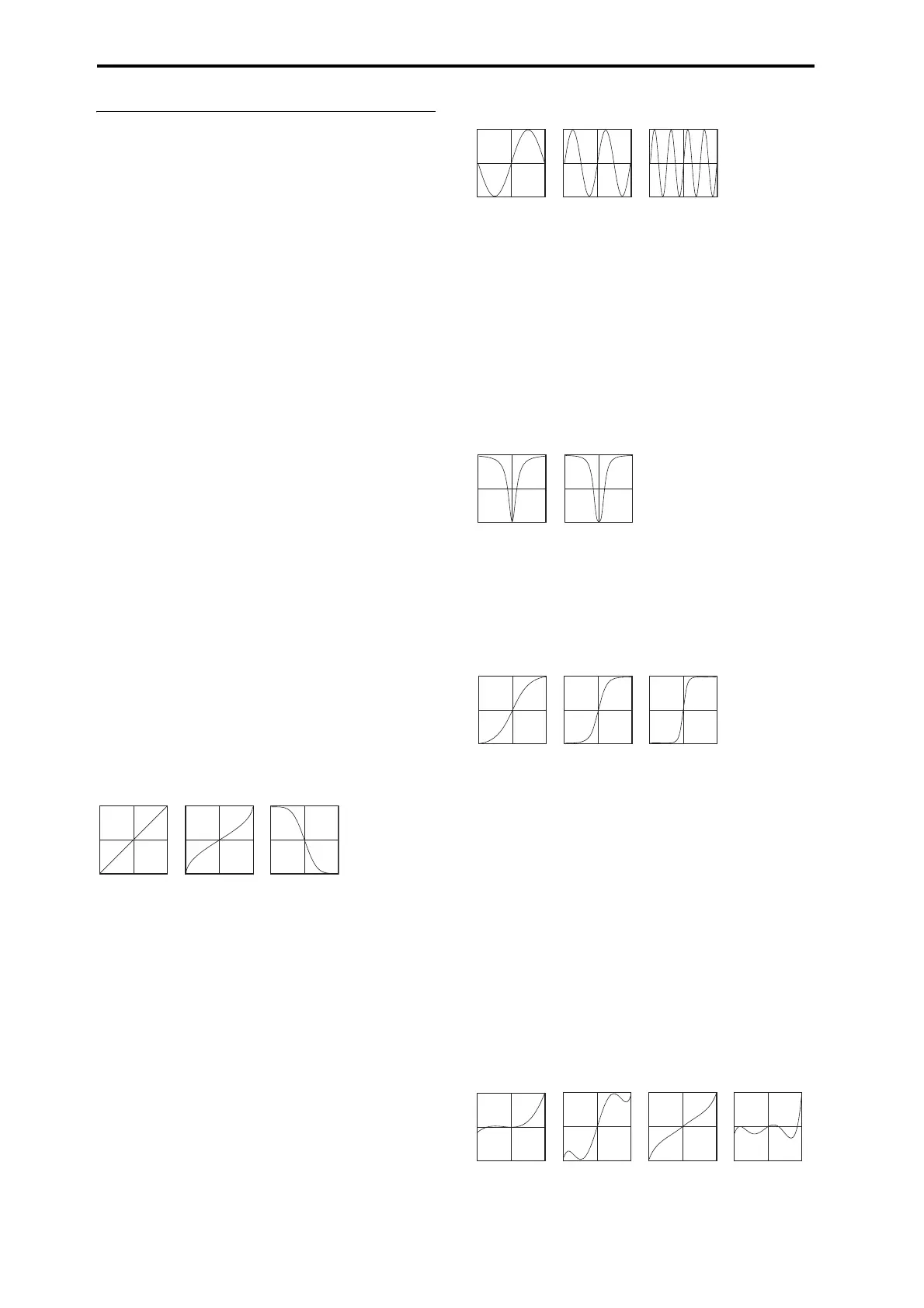EXi: MOD-7 Waveshaping VPM Synthesizer
328
5–4c: Waveshaper
This section is available only when the Mode is set to Sine +
Waveshaper or Waveshaper.
Note that, if the same oscillator is using both FM and
waveshaping, they occur in that order: first the sine oscillator
is modulated by the inputs, and then the result is
waveshaped.
For more information about using the waveshaper, including
hands-on tutorials, see “Waveshaping” on page 306.
Table [List of tables]
This selects the table used by the waveshaper. The
waveshaping effect will be a combination of the input signal
(including both the waveform and the signal level), the
selected table, and the settings for Drive and Offset.
Linear, Sine->Tri, and Step
Linear: This simple table does not alter the signal, as long as
levels are within the range of the table. Extremely high input
levels, or Drive settings over 0dB, may still cause clipping.
Non-zero values of Offset may also cause clipping on either
the positive or negative side, changing the waveform’s
symmetry.
Sine->Tri: With full-scale sine input, this table creates a
triangle waveform. If you just want to create a triangle
waveform, setting the Mode to Triangle will work a little
better, but this table allows you to use Drive and Offset in
creative ways.
For a basic triangle waveform, set the Key Slope to 1, and
set the Key Slope Mode to roll off only above C4. For more
mellow, sine-like tones, reduce the Drive; for sharper
timbres, increase it.
Step: This table creates soft clipping. Increasing the input
level and/or Drive creates harder clipping.
With a full-scale sine wave, the output is something like a
soft square wave, with Offset being similar to pulse width.
Sines
With sine wave input, these tables produce output similar to
a simple FM pair with the Carrier:Modulator ratio set to 0:1.
Drive functions like the FM input level, and responds well to
AMS modulation. With full-scale input, Drive settings over
0dB will cause clipping.
The tables differ only in their maximum brightness. Sine4 is
the brightest, for the broadest range of timbres. Sine2 is
darker, and Sine is darker still; these offer finer control with
Drive modulation, for more subtle coloration.
Sine4: When Drive is at 0dB, this table is like 0:1 FM with
the carrier level at maximum. To produce a similar effect to
Sine2, reduce the Drive by 6dB; to produce a similar effect
to Sine, reduce the Drive by 12dB.
Sine and Sine2: These are darker versions of Sine4.
Pickups
These tables simulate electromagnetic pickups, such as those
of an electric piano. Drive functions as the signal gain.
To create electric piano sounds, use a sine wave as input, and
assign an EG to modulate Drive; it should be around 0dB at
first, and then decay exponentially to a very low value.
Offset controls the distance between the pickup and the
center of the tine; typically, values close to 0 will work well.
Pickup1: This simulates a bright electromagnetic pickup.
Pickup2: This creates a different amount of saturation; its
tone is slightly darker than Pickup1.
Tanh
Tanh2, 4, and 8: These create soft clipping, similar to the
Step. Vary the Drive to control the amount of distortion. 2,
4, and 8 produce increasing amounts of clipping. Full-scale
sine wave input will produce output similar to a soft-edged
square wave.
Additive
While the Additive tables can produce interesting results
with any input signal, they produce the described results
only with a full-scale sine wave. Reducing the Drive (or the
level of the sine wave input) will diminish the level of the
additive harmonics, making the result sound more like the
original sine. Dynamic modulation of Drive may sound
similar to a filter opening and closing.
Add Saw 3Harm: This produces the first three harmonics of
a sawtooth.
Add Square 3Harm: This produces the first three
harmonics of a square wave.
Add Tri 3Harm: This produces the first three harmonics of
a triangle wave.
Add 12345: This produces harmonics 1 through 5 with
equal amplitude, similar to a filtered pulse waveform.
Add 1Plus2: This produces the fundamental plus the 2nd
harmonic at equal amplitude, and sounds like an 8’ + 4’
organ stop.
Sine Sine2 Sine4
Pickup1 Pickup2
Tanh 2 Tanh 4 Tanh 8
Add Saw 3Harm Add Square 3Harm Add Tr i 3Harm Add 12345

